Strikingly handsome Tyrone Power (1914-1959) was one of the great romantic swashbuckling stars of Hollywood’s golden age. From the 1930s to the 1950s, Power starred in such adventure films as The Mark of Zorro (1940), Blood and Sand (1941), The Black Swan (1942), Captain from Castile (1947), Prince of Foxes (1949) and The Black Rose (1950). Among his best films are the Film Noir Nightmare Alley (1949) and Billy Wilder’s Witness for the Prosecution (1957). In the 1950s, he devoted more time to theatre productions and received accolades for his roles in 'John Brown's Body' and 'Mister Roberts'. Power died from a heart attack at the age of 44.
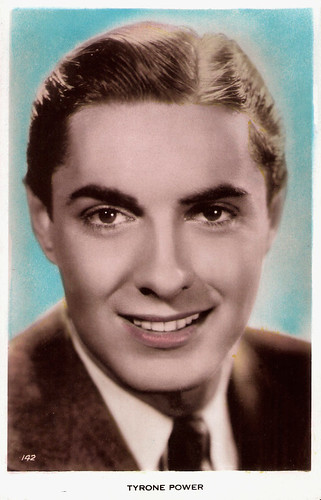
British postcard by Art Photo Postcard, no. 142.

British postcard by Art Photo. Tyrone Power and Norma Shearer in Marie-Antoinette (W.S. Van Dyke, 1938). Photo: Metro-Goldwyn-Mayer. Collection: Marlene Pilaete.
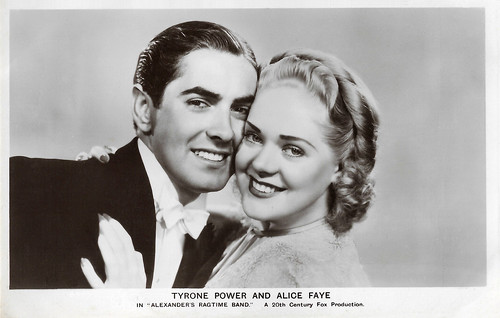
British Real Photograph postcard, London, no. FS 176. Photo: 20th Century Fox. Publicity still for Alexander's Ragtime Band (Henry King, 1938) with Alice Faye.
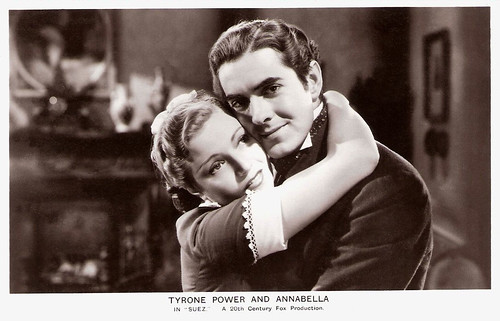
British postcard by Real Photograph, London, nr. FS 177. Photo: 20th Century Fox. Publicity still for Suez (Allan Dwan, 1938), with Annabella. Suez is a highly fictionalised biographical account of the builder of the Suez Canal, Ferdinand de Lesseps.

British Real Photograph postcard, London, no. FS 178. Photo: 20th Century Fox. Publicity still for Suez (Allan Dwan, 1938) with Loretta Young.
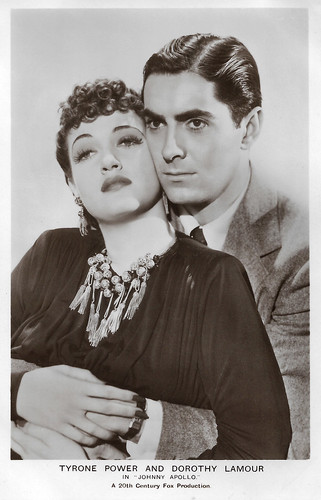
British postcard in the Film Partners Series, London, no. P 325. Photo: 20th Century Fox. Publicity still for Johnny Apollo (Henry Hathaway, 1940) with Dorothy Lamour.

British postcard in the Picturegoer Series, London, no. 1218a. Photo: 20th Century Fox. Tyrone Power in Brigham Young (Henry Hathaway, 1940).

Dutch or Belgian postcard by Korès. Photo: 20th Century Fox. Linda Darnell and Tyrone Power in The Mark of Zorro (Rouben Mamoulian, 1940).
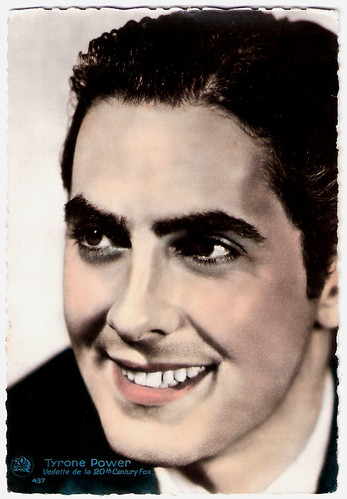
French postcard, no. 437. Photo: 20th Century Fox.

French collector card by Massilia. Photo: Fox.
Tyrone Edmund Power, Jr. (also called Tyrone Power III) was born at his mother's home in Cincinnati, Ohio, in 1914. He was the third Tyrone Power of four in a famed acting dynasty reaching back to the eighteenth century. His great-grandfather was the first Tyrone Power (1795-1841), a famed Irish comedian. His father, known to historians as Tyrone Power Sr., but to his contemporaries as either Tyrone Power or Tyrone Power the Younger, was a huge star in the theatre and later in films. On stage, he acted in both classical and modern roles. His mother, Helen Emma ‘Patia’ née Reaume (Mrs. Tyrone Power), was also a Shakespearean actress as well as a respected dramatic coach. A frail, sickly child, Tyrone was taken by his parents to the warmer climate of southern California. He made his stage debut at age seven, appearing with his father in a stage production at San Gabriel Mission.
After his parents' divorce, he and his sister Anne Power returned to Cincinnati with their mother. There, he attended school while developing an obsession with acting. Although raised by his mother, he corresponded with his father, who encouraged his acting dreams. He was a supernumerary in his father's stage production of 'The Merchant of Venice' in Chicago. After turning professional, Power supported himself between engagements, working as a theatre usher and other such odd jobs. Tyrone was scheduled to make his film debut playing with his father, Tyrone Power Sr., in The Miracle Man (Norman Z. McLeod, 1932). Tyrone held his father as he died suddenly of a heart attack while preparing for his role. They were both replaced. Although he was startlingly handsome, young Tyrone struggled to find work in Hollywood. He appeared in a few small roles, then went east to do stage work in Katherine Cornell's theatrical company. Among the Broadway plays in which he was cast are 'Flowers of the Forest', 'Saint Joan', and 'Romeo and Juliet'.
A screen test led to a contract at 20th Century Fox in 1936. Power was cast in a supporting role in the Simone Simon vehicle Girl's Dormitory (Irving Cummings, 1936). The reaction from preview audiences to Fox's new contractee was so enthusiastic that Darryl F. Zanuck ordered that Power's part be expanded for the final release version. Power played the lead in the drama Lloyd's of London (Henry King, 1936) opposite Madeleine Carroll and Guy Standing. Loosely based on historical events, the film follows the dealings of a man who works for Lloyd's of London during the Napoleonic Wars.
Lloyd's of London was a hit; it demonstrated that 22-year-old Power, in his first starring role, could carry a film, and that the newly formed 20th Century Fox was a major Hollywood studio. He walked into the premiere of the film as an unknown, and he walked out a star, which he remained for the rest of his career. As Fox's biggest male star, he played in contemporary and period pieces with ease. Power racked up hit after hit from 1936 until 1943. Jim Beaver at IMDb: “Most of his roles were colourful without being deep, and his swordplay was more praised than his wordplay.”
He was loaned out by Fox once, to MGM for Marie Antoinette (W. S. Van Dyke, 1938), starring Norma Shearer as Marie Antoinette. The film was based on the 1932 biography of the ill-fated Queen of France by the Austrian writer Stefan Zweig. Fox mogul Darryl F. Zanuck was angry that MGM used Fox's biggest star in what was, despite billing, a supporting role, and he vowed never again to loan him out. After the hit The Mark of Zorro (Rouben Mamoulian, 1940), Power's career took a dramatic turn. He became the romantic, swashbuckling hero of such adventure films as Blood and Sand (Rouben Mamoulian, 1941) with Rita Hayworth, and The Black Swan (Henry King, 1942) with Maureen O’Hara.
In 1943, Power served in the Marine Corps in World War II as a transport pilot, and he saw action in the Pacific Theatre of Operations. Hal Erickson at AllMovie: "Power was a much better actor than he was given credit for at the time. He also handled his celebrity like an old pro; he was well-liked by his co-stars and crew, and from all reports was an able and respected leader of men while serving as a Marine Corps officer during World War II."

French postcard by Editions P.I., Paris, no. 542.
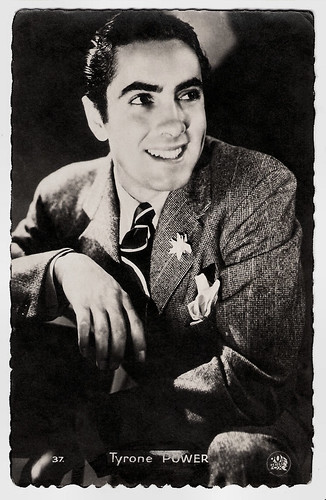
French postcard, no. 37. Photo: 20th Century Fox.

British Real Photograph postcard, London, no. FS 94. Photo: 20th Century Fox. Madeleine Carroll and Tyrone Power in Lloyd's of London (Henry King, 1936).

British Real Photograph postcard, London, no. FS 126. Photo: 20th Century Fox. Sonja Henie and Tyrone Power in Thin Ice (Sidney Lanfield, 1937). Lovely To Look At was the British film title.

German postcard by Ross Verlag, no. A 1486/1, 1937-1938. Photo: 20th Century Fox.

German postcard by Ross Verlag, no. A 1677/2, 1937-1938. Photo: 20th Century Fox.

Latvian postcard by EMBR, no. 3328. Photo: 20th Century Fox. Alice Faye and Tyrone Power in In Old Chicago (Henry King, 1938). Collection: Marlène Pilaete.

British postcard in the Colourgraph Series, London, no. C 306. Photo: Metro Goldwyn Mayer. Tyrone Power in Marie-Antoinette (W. S. Van Dyke, 1938).
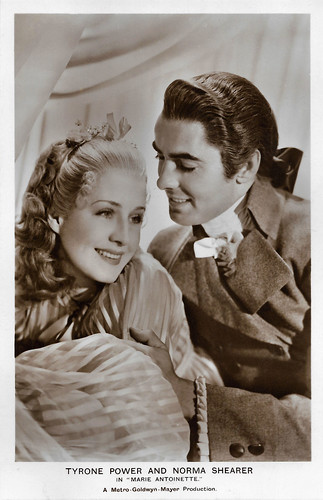
British Real Photograph postcard, London, no. FS 180. Photo: Metro-Goldwyn-Mayer. Publicity still for Marie Antoinette (W.S. Van Dyke, 1938) with Norma Shearer.

British Real Photograph postcard, London, no. FS 201. Photo: 20th Century Fox. Tyrone Power and Myrna Loy in The Rains Came (Clarence Brown, 1939).
After the war, Tyrone Power got his best reviews for an atypical part as a downward-spiralling con-man in the Film Noir Nightmare Alley (Edmund Goulding, 1947). Although he remained a huge star, much of his post-war work was unremarkable. Zanuck released several costume-clad adventure films with Power, including Captain from Castile (Henry King, 1947), Prince of Foxes (Henry King, 1949) with Orson Welles, and The Black Rose (Henry Hathaway, 1950) with Cécile Aubry.
He continued to do notable stage work and also began producing films. Darryl F. Zanuck persuaded him to play the lead role in The Sun Also Rises (Henry King, 1957), adapted from the Ernest Hemingway novel, with Ava Gardner and Errol Flynn. This was his final film with Fox. Power gave a fine performance opposite Marlene Dietrich and Charles Laughton in the Agatha Christie adaptation Witness for the Prosecution (Billy Wilder, 1957).
Next, Power began production on Solomon and Sheba (King Vidor, 1959). Halfway through shooting, he collapsed during a duelling scene with George Sanders, and he died of a heart attack before reaching a hospital. He was replaced by Yul Brynner. Power’s last complete work was a public-service announcement for television (in which he appeared on a motion-picture set in costume) about spotting the signs of a heart attack and going to the hospital to have a doctor check it out...
Power had been married three times. His first wife was French actress Annabella (1939-1948). After their divorce, he married Mexican actress Linda Christian (1949-1956), with whom he had two daughters, singer-actress Romina Francesca Power (1951) and actress Taryn Power (1953).
His third wife was Deborah Jean Smith Minardos (7 May 1958 - 15 November 1958; his death). Their son, Tyrone William Power IV (1959), was born, some two months after Power's death. He became known professionally as Tyrone Power Jr., and also followed his father in the family acting tradition. Power was also the adoptive father of Annabella’s daughter, Ann Power. Tyrone Power is interred at Hollywood Memorial Cemetery (now called Hollywood Forever), Hollywood, CA. His tombstone includes the masks of Comedy and Tragedy and the inscription, "Good night, sweet prince...".

Vintage postcard. Photo: 20th Century Fox.

German postcard by Kolibri-Verlag. Photo: Twentieth Century Fox. Tyrone Power in Blood and Sand (Rouben Mamoulian, 1941).

Italian postcard by B.F.F. Edit., no. 2020. Photo: 20th Century Fox. Tyrone Power in This Above All (Anatole Litvak, 1942).
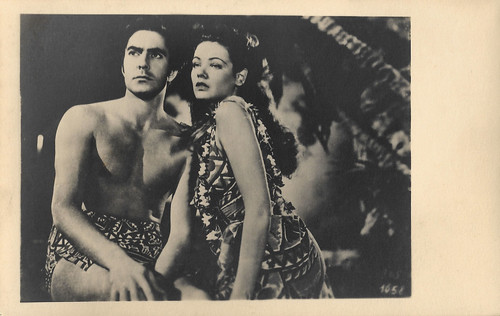
Vintage card, no. 1658. Photo: 20th Century Fox. Publicity still for Son of Fury - The Story of Benjamin Blake (John Cromwell, 1942) with Gene Tierney.

Spanish postcard. Anne Baxter and Tyrone Power in Crash Drive (Archie Mayo, 1943). Collection: Marlène Pilaete.

Italian postcard by Edizioni Beatrice D'Este in the Photocards series, no. 20192. Photo: Twentieth Century Fox. Publicity still for Crash Dive (Archie Mayo, 1943). On the card, Tyrone Power's name is misspelt.
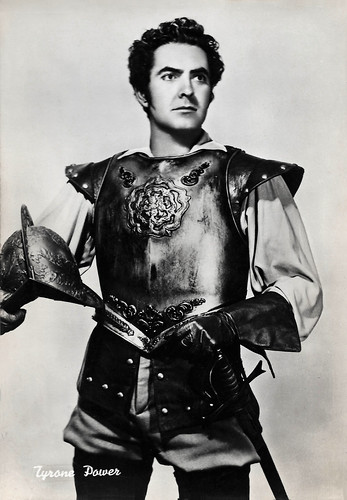
Italian postcard by Bromofoto, Milano, no. 219. Photo: 20th Century Fox. Publicity still for Captain from Castile (Henry King, 1947).

German postcard by Wilhelm Schulze-Witteborg Grafischer Betrieb, Wanne-Eickel. Photo: 20th Century Fox.
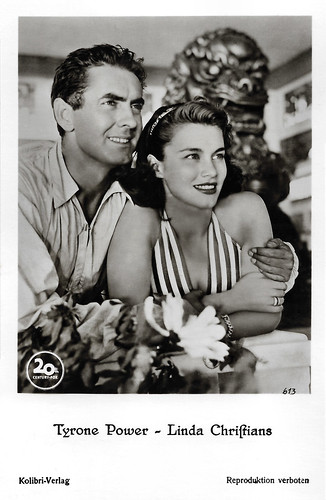
With Linda Christian. German postcard by Kolibri-Verlag, no. 613. Photo: 20th Century Fox.

Spanish postcard by SOBE, no. 563. Photo: 20th Century Fox. Tyrone Power and Wanda Hendrix in Prince of Foxes (Henry King, 1949).
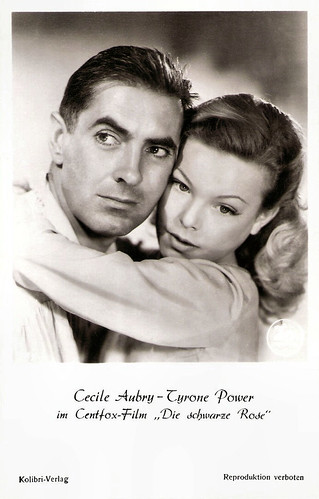
German postcard by Kolibri-Verlag. Photo: 20th Century Fox. Still from The Black Rose (1950) with Cécile Aubry.

West German postcard by Film-Foto-Verlag, Berlin-Tempelhof, no. FK 272. Photo: 20th Century Fox. Tyrone Power in The House in the Square (Roy Ward Baker, 1951).

French postcard by Huit, Paris, French licence holder for ISV, no. B 4. Photo: 20th Century Fox. Tyrone Power in King of the Khyber Rifles (Henry King, 1953).
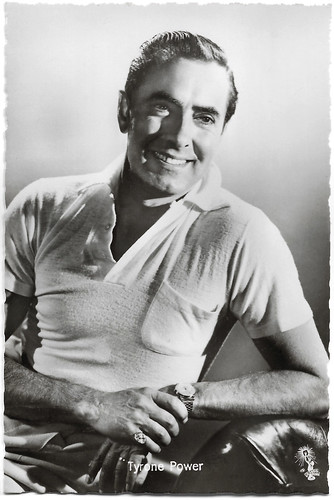
German postcard by Kolibri-Verlag G.m.b.H., Minden/Westf., no. 2496. Photo: Columbia Pictures. Publicity still for The Eddy Duchin Story (George Sidney, 1956).
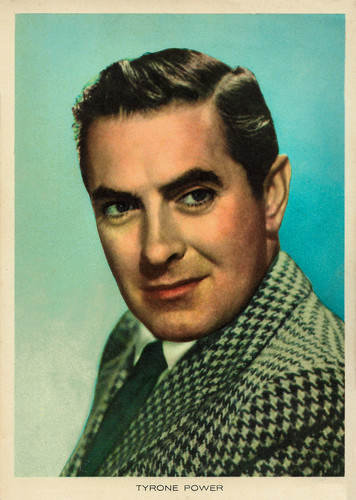
Italian postcard by Vannina, Milano.

Belgian postcard by Edition H. Troukens, Hofstede, licence holder for Ufa, Berlin-Tempelhof, no. 1038. Photo: Ufa.
Sources: Jim Beaver (IMDb), Hal Erickson (AllMovie - Page now defunct), Wikipedia, and IMDb.

British postcard by Art Photo Postcard, no. 142.

British postcard by Art Photo. Tyrone Power and Norma Shearer in Marie-Antoinette (W.S. Van Dyke, 1938). Photo: Metro-Goldwyn-Mayer. Collection: Marlene Pilaete.

British Real Photograph postcard, London, no. FS 176. Photo: 20th Century Fox. Publicity still for Alexander's Ragtime Band (Henry King, 1938) with Alice Faye.

British postcard by Real Photograph, London, nr. FS 177. Photo: 20th Century Fox. Publicity still for Suez (Allan Dwan, 1938), with Annabella. Suez is a highly fictionalised biographical account of the builder of the Suez Canal, Ferdinand de Lesseps.

British Real Photograph postcard, London, no. FS 178. Photo: 20th Century Fox. Publicity still for Suez (Allan Dwan, 1938) with Loretta Young.

British postcard in the Film Partners Series, London, no. P 325. Photo: 20th Century Fox. Publicity still for Johnny Apollo (Henry Hathaway, 1940) with Dorothy Lamour.

British postcard in the Picturegoer Series, London, no. 1218a. Photo: 20th Century Fox. Tyrone Power in Brigham Young (Henry Hathaway, 1940).

Dutch or Belgian postcard by Korès. Photo: 20th Century Fox. Linda Darnell and Tyrone Power in The Mark of Zorro (Rouben Mamoulian, 1940).

French postcard, no. 437. Photo: 20th Century Fox.

French collector card by Massilia. Photo: Fox.
Walking out of the premiere as a star
Tyrone Edmund Power, Jr. (also called Tyrone Power III) was born at his mother's home in Cincinnati, Ohio, in 1914. He was the third Tyrone Power of four in a famed acting dynasty reaching back to the eighteenth century. His great-grandfather was the first Tyrone Power (1795-1841), a famed Irish comedian. His father, known to historians as Tyrone Power Sr., but to his contemporaries as either Tyrone Power or Tyrone Power the Younger, was a huge star in the theatre and later in films. On stage, he acted in both classical and modern roles. His mother, Helen Emma ‘Patia’ née Reaume (Mrs. Tyrone Power), was also a Shakespearean actress as well as a respected dramatic coach. A frail, sickly child, Tyrone was taken by his parents to the warmer climate of southern California. He made his stage debut at age seven, appearing with his father in a stage production at San Gabriel Mission.
After his parents' divorce, he and his sister Anne Power returned to Cincinnati with their mother. There, he attended school while developing an obsession with acting. Although raised by his mother, he corresponded with his father, who encouraged his acting dreams. He was a supernumerary in his father's stage production of 'The Merchant of Venice' in Chicago. After turning professional, Power supported himself between engagements, working as a theatre usher and other such odd jobs. Tyrone was scheduled to make his film debut playing with his father, Tyrone Power Sr., in The Miracle Man (Norman Z. McLeod, 1932). Tyrone held his father as he died suddenly of a heart attack while preparing for his role. They were both replaced. Although he was startlingly handsome, young Tyrone struggled to find work in Hollywood. He appeared in a few small roles, then went east to do stage work in Katherine Cornell's theatrical company. Among the Broadway plays in which he was cast are 'Flowers of the Forest', 'Saint Joan', and 'Romeo and Juliet'.
A screen test led to a contract at 20th Century Fox in 1936. Power was cast in a supporting role in the Simone Simon vehicle Girl's Dormitory (Irving Cummings, 1936). The reaction from preview audiences to Fox's new contractee was so enthusiastic that Darryl F. Zanuck ordered that Power's part be expanded for the final release version. Power played the lead in the drama Lloyd's of London (Henry King, 1936) opposite Madeleine Carroll and Guy Standing. Loosely based on historical events, the film follows the dealings of a man who works for Lloyd's of London during the Napoleonic Wars.
Lloyd's of London was a hit; it demonstrated that 22-year-old Power, in his first starring role, could carry a film, and that the newly formed 20th Century Fox was a major Hollywood studio. He walked into the premiere of the film as an unknown, and he walked out a star, which he remained for the rest of his career. As Fox's biggest male star, he played in contemporary and period pieces with ease. Power racked up hit after hit from 1936 until 1943. Jim Beaver at IMDb: “Most of his roles were colourful without being deep, and his swordplay was more praised than his wordplay.”
He was loaned out by Fox once, to MGM for Marie Antoinette (W. S. Van Dyke, 1938), starring Norma Shearer as Marie Antoinette. The film was based on the 1932 biography of the ill-fated Queen of France by the Austrian writer Stefan Zweig. Fox mogul Darryl F. Zanuck was angry that MGM used Fox's biggest star in what was, despite billing, a supporting role, and he vowed never again to loan him out. After the hit The Mark of Zorro (Rouben Mamoulian, 1940), Power's career took a dramatic turn. He became the romantic, swashbuckling hero of such adventure films as Blood and Sand (Rouben Mamoulian, 1941) with Rita Hayworth, and The Black Swan (Henry King, 1942) with Maureen O’Hara.
In 1943, Power served in the Marine Corps in World War II as a transport pilot, and he saw action in the Pacific Theatre of Operations. Hal Erickson at AllMovie: "Power was a much better actor than he was given credit for at the time. He also handled his celebrity like an old pro; he was well-liked by his co-stars and crew, and from all reports was an able and respected leader of men while serving as a Marine Corps officer during World War II."

French postcard by Editions P.I., Paris, no. 542.

French postcard, no. 37. Photo: 20th Century Fox.

British Real Photograph postcard, London, no. FS 94. Photo: 20th Century Fox. Madeleine Carroll and Tyrone Power in Lloyd's of London (Henry King, 1936).

British Real Photograph postcard, London, no. FS 126. Photo: 20th Century Fox. Sonja Henie and Tyrone Power in Thin Ice (Sidney Lanfield, 1937). Lovely To Look At was the British film title.

German postcard by Ross Verlag, no. A 1486/1, 1937-1938. Photo: 20th Century Fox.

German postcard by Ross Verlag, no. A 1677/2, 1937-1938. Photo: 20th Century Fox.

Latvian postcard by EMBR, no. 3328. Photo: 20th Century Fox. Alice Faye and Tyrone Power in In Old Chicago (Henry King, 1938). Collection: Marlène Pilaete.

British postcard in the Colourgraph Series, London, no. C 306. Photo: Metro Goldwyn Mayer. Tyrone Power in Marie-Antoinette (W. S. Van Dyke, 1938).

British Real Photograph postcard, London, no. FS 180. Photo: Metro-Goldwyn-Mayer. Publicity still for Marie Antoinette (W.S. Van Dyke, 1938) with Norma Shearer.

British Real Photograph postcard, London, no. FS 201. Photo: 20th Century Fox. Tyrone Power and Myrna Loy in The Rains Came (Clarence Brown, 1939).
Good night, sweet prince...
After the war, Tyrone Power got his best reviews for an atypical part as a downward-spiralling con-man in the Film Noir Nightmare Alley (Edmund Goulding, 1947). Although he remained a huge star, much of his post-war work was unremarkable. Zanuck released several costume-clad adventure films with Power, including Captain from Castile (Henry King, 1947), Prince of Foxes (Henry King, 1949) with Orson Welles, and The Black Rose (Henry Hathaway, 1950) with Cécile Aubry.
He continued to do notable stage work and also began producing films. Darryl F. Zanuck persuaded him to play the lead role in The Sun Also Rises (Henry King, 1957), adapted from the Ernest Hemingway novel, with Ava Gardner and Errol Flynn. This was his final film with Fox. Power gave a fine performance opposite Marlene Dietrich and Charles Laughton in the Agatha Christie adaptation Witness for the Prosecution (Billy Wilder, 1957).
Next, Power began production on Solomon and Sheba (King Vidor, 1959). Halfway through shooting, he collapsed during a duelling scene with George Sanders, and he died of a heart attack before reaching a hospital. He was replaced by Yul Brynner. Power’s last complete work was a public-service announcement for television (in which he appeared on a motion-picture set in costume) about spotting the signs of a heart attack and going to the hospital to have a doctor check it out...
Power had been married three times. His first wife was French actress Annabella (1939-1948). After their divorce, he married Mexican actress Linda Christian (1949-1956), with whom he had two daughters, singer-actress Romina Francesca Power (1951) and actress Taryn Power (1953).
His third wife was Deborah Jean Smith Minardos (7 May 1958 - 15 November 1958; his death). Their son, Tyrone William Power IV (1959), was born, some two months after Power's death. He became known professionally as Tyrone Power Jr., and also followed his father in the family acting tradition. Power was also the adoptive father of Annabella’s daughter, Ann Power. Tyrone Power is interred at Hollywood Memorial Cemetery (now called Hollywood Forever), Hollywood, CA. His tombstone includes the masks of Comedy and Tragedy and the inscription, "Good night, sweet prince...".

Vintage postcard. Photo: 20th Century Fox.

German postcard by Kolibri-Verlag. Photo: Twentieth Century Fox. Tyrone Power in Blood and Sand (Rouben Mamoulian, 1941).

Italian postcard by B.F.F. Edit., no. 2020. Photo: 20th Century Fox. Tyrone Power in This Above All (Anatole Litvak, 1942).

Vintage card, no. 1658. Photo: 20th Century Fox. Publicity still for Son of Fury - The Story of Benjamin Blake (John Cromwell, 1942) with Gene Tierney.

Spanish postcard. Anne Baxter and Tyrone Power in Crash Drive (Archie Mayo, 1943). Collection: Marlène Pilaete.

Italian postcard by Edizioni Beatrice D'Este in the Photocards series, no. 20192. Photo: Twentieth Century Fox. Publicity still for Crash Dive (Archie Mayo, 1943). On the card, Tyrone Power's name is misspelt.

Italian postcard by Bromofoto, Milano, no. 219. Photo: 20th Century Fox. Publicity still for Captain from Castile (Henry King, 1947).

German postcard by Wilhelm Schulze-Witteborg Grafischer Betrieb, Wanne-Eickel. Photo: 20th Century Fox.

With Linda Christian. German postcard by Kolibri-Verlag, no. 613. Photo: 20th Century Fox.

Spanish postcard by SOBE, no. 563. Photo: 20th Century Fox. Tyrone Power and Wanda Hendrix in Prince of Foxes (Henry King, 1949).

German postcard by Kolibri-Verlag. Photo: 20th Century Fox. Still from The Black Rose (1950) with Cécile Aubry.

West German postcard by Film-Foto-Verlag, Berlin-Tempelhof, no. FK 272. Photo: 20th Century Fox. Tyrone Power in The House in the Square (Roy Ward Baker, 1951).

French postcard by Huit, Paris, French licence holder for ISV, no. B 4. Photo: 20th Century Fox. Tyrone Power in King of the Khyber Rifles (Henry King, 1953).

German postcard by Kolibri-Verlag G.m.b.H., Minden/Westf., no. 2496. Photo: Columbia Pictures. Publicity still for The Eddy Duchin Story (George Sidney, 1956).

Italian postcard by Vannina, Milano.

Belgian postcard by Edition H. Troukens, Hofstede, licence holder for Ufa, Berlin-Tempelhof, no. 1038. Photo: Ufa.
Sources: Jim Beaver (IMDb), Hal Erickson (AllMovie - Page now defunct), Wikipedia, and IMDb.
No comments:
Post a Comment